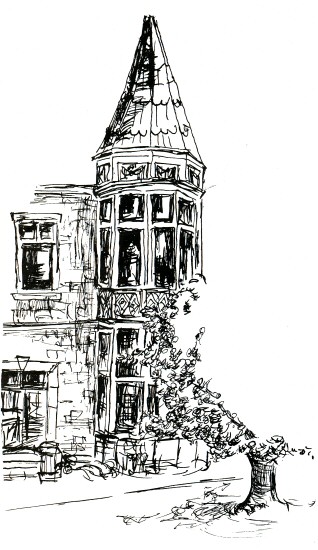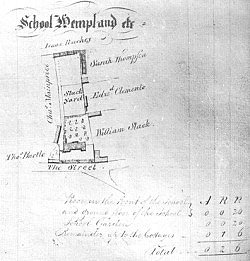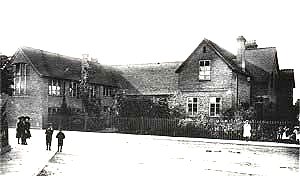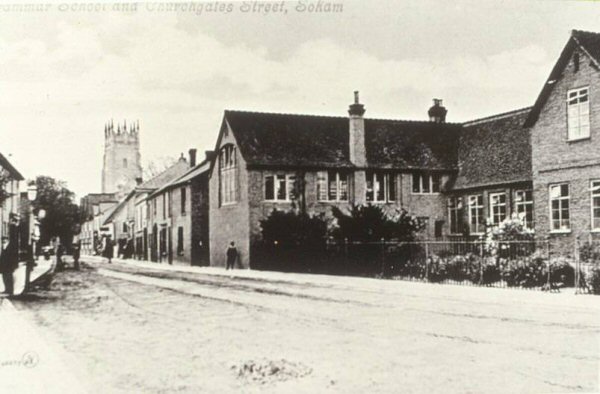A HISTORY OF SOHAM GRAMMAR SCHOOL [how the history came
to be written]
J R Browning, from the Soham Grammarian Coronation issue,
Summer 1953
It must have been late September, for I can recall the close heat of
the old Lower VA room, where I was spending a free period looking across
the lawn to the shrubbery - September, 1950, and the Headmaster came in
with a small folder in his hand. He told me that this contained various
papers relating to the School and asked me whether I would like to write
an account of its history.
I agreed and thus began The History of Soham Grammar School,
which, it is hoped, will appear in 1954, but as a longer, more
comprehensive treatment than either the Head or I had ever conceived.
A first examination of the folder caused feelings similar to those that
must have smitten the unfortunate suitors for Portia's hand when they
opened their caskets - but that was the end of their quest, whereas mine
I could see already was to be extensive and prolonged.
The earliest document, so far as I can recall, was about seventy years
old and I believed the school to be two hundred years older than that!
Frantic searching through various histories of Cambridgeshire showed
that there must be some documentary El Dorado, but where ?
It was some months before these priceless documents were unearthed not
half-a-dozen yards from where Soham Parish Council sits in august and
awful majesty and the Old Folks' Club meets in fantastic revelry. There
they lay, crumpled and musty, and they held all that can now be known of
the origins and development of the Grammar School.
They are, almost without exception, receipts of those sturdy men who
administered the School as part of the Soham Free School Moor Trust
the Gentlemen Feoffees: no informative minutes of meetings, no letters
in fine scholarly or crabbed hand of master or boy, no fragments of the
work that must have gone on in the school, just bills and accounts and
receipts: the few remaining bones of the skeleton.
Yet reconstruct with infinite patience, skill and imagination your
skeletal brontosaurus, then clothe him according to fancy in flesh, and
though his form stands before you, the whole age and the enormous mass
of common-place, day-to-day detail eludes you: you can only guess at
what must have been.
So with this: facts and figures, a few parchments, an odd domestic
detail from the Feoffees' Account Book - with this unpromising though
enormously interesting material and lacking the attributes mentioned of
the skilled palaeontologist, I began to reconstruct the History of the
Grammar School.
Fortunately, information and help were both forthcoming. In Pembroke
College Treasury, surely the coldest place in Cambridge despite the
warmth one feels on reading Gray's 'Elegy' in the original manuscript, I
came across several vitally important documents.
One of them contained this clause, which for us far surpasses in
significance and interest all the rest: "That the remainder of Soham
Moor being 116 acres be settled in Feoffees to he chosen by the Lord of
the Manor and the tenants . . . the Moor to be sufficiently imbanked . .
. the charges thereof and surveying and setting out of the commons
should be borne by the Feoffees out of the rents of the said 116 acres
and the overplus to be for a Town stock, for to set the poor on work,
binding out apprentices, raising a revenue for a Scholemaster
as the Lord of the Manor and major part of the tenants should order."
My italics - and the date is the twentieth day of December, 1664. Now
that, of course, is only the beginning of the story. When this provision
became practical politics*, how and in what place, are all told in the
History, which also deals with the vicissitudes through which the
Grammar School was to pass.
Notice this description Grammar School, for I have examined evidence of
the most diverse kind to try to establish that it was, in origin, a free
Grammar School, not just a charity school. There was a danger, from
which a new Scheme of Management in 1845 only just rescued us, that the
Grammar School status might be denied for the future: there was a period
when the school was closed not long afterwards and, let us pay tribute
to the good sense of the people of Soham, exercised not for the first
time, there was a petition that " this Valuable Institution be
re-opened." The period up to 1945 is fully covered and the Headmaster
will add an epilogue, 1945-1953.
Perhaps the mention of Pembroke College, which appears so often in the
narrative, may puzzle you: here the Vicar of Soham, the Rev. Canon P. F.
Boughey, helped to make clear the link that existed between this
Cambridge College and the parish of Soham and, later, its Grammar
School, particularly in the period 1686-1878: that link is still
strongly maintained even now.
Mrs. Fenton, a daughter of that William Feather who became Master in
1866, Mr. Lavender Porter of Haddenham, a remarkable Old Boy, the oldest
now surviving, Mr. E. Leonard, another Old Boy and Chairman of the
Governors 1947-52, Mr. Ford, and many Old Boys have helped and will be
thanked at the appropriate time, for they shed light on dark places.
Of the more personal aspect, a few words. One C. Priestley is the first
recorded master, and reasons are shown why he was probably the first of
all in the line of worthy men who have taught in the School since its
foundation. The full list of those who followed is known and set out,
among them one Bennet, who obliged the Feoffees to consult counsel's
opinion. What tussle lay behind this ?
"On the representation made to me by Mr. John Kent of Soham, I am of
opinion that the Feoffees may displace Bennet, formerly by them
appointed to teach writing school at Soham, and may appoint a new
writing master in his stead and likewise the Trustees of the School
House who have given Bennet leave to dwell there as long as they
should think fit may turn him out at their pleasure." L. Bune.
January, 1740.
It has been difficult to do more than hint at the nature and scope of
the History: no author is an impartial or an able critic of his own
work, but I think the facts, no matter how badly or baldly they are put
down, cannot fail to interest all Old Boys. Bearing in mind what the
Free School Charity meant to Soham, recalling the close connection of
the Grammar School throughout its whole history with the parish and
people of Soham, I think also that the book should prove interesting to
all local people. The Grammar School was, in origin, the handwork of the
people of Soham and, in truth, it was their Grammar School - they and
you should be proud of what they wrought.
[The book was eventually published in 1972: on this website priority is
being given the the more recent history of the school. However if you
have material relating to the period before 1916, please contact the
website editor.]
* from Chapter I of the History
Historically, then, the position was this, that provision had
been made as early as the deed poll of 1664 for the raising of a
revenue for a schoolmaster as well as for the other uses mentioned.
Despite Sir Thomas Chicheley's position as one of His Majesty's Privy
Council he had no ex-officio power to make legally binding any of the
clauses of the deed-poll: in fact, we have seen that, as lord of the
Manor, he was happier if the old state of affairs prevailed. The really
firm and legal enactment comes in the Exchequer Court decree of 26
April 1686, so that while on grounds of chronology one might say
that the school was envisaged 22 years earlier, in fact, its
statutory basis and its legal foundation must be taken as dating
from 1686.
from the Soham Grammarian Summer 1969

who provided this drawing and who wrote the article? |
Origins
Soham Grammar School grew out of the very nature of the
land on which it stands. The town of Soham, standing in the
south-eastern corner of the great Fen Lands, straggles along
what was once the bank of the largest of the fenland lakes,
Soham Mere.
In ancient times a place of more importance than today
Soham was one of the earliest parts of East Anglia to be
converted to Christianity and, while a large pagan
Anglo-Saxon cemetery has been excavated to the east of the
village, a very early Christian burial ground has been
uncovered at its west end on the site of the parish glebe
land.
When, many years after the famous voyage along the Ouse
past Ely, Canute, now king and Christian, re-visited that
city he reached it by sled across frozen Soham Mere.
In the great Domesday survey of 1086-7 Soham appears as the
most important of the royal manors and lands of
Cambridgeshire, heading the list of royal estates in the
county. Its decline was due in part to the increased
importance of Ely once a cathedral was established there in
1109, and partly to the improvement in communications which
followed the drainage of the Fens in the seventeeth and
eighteenth centuries.
Like all the other ancient fen settlements, the prosperity
of Soham depended upon the waters and marshes surrounding it
where fish could be caught, birds netted, reeds and turves
cut and eels and lampreys landed in their tens of thousands.
|
It was through the drainage of these waters and marshes and the
disputes attendant upon the drainage that the Grammar School came into
being. The drainage and enclosure of the Fens everywhere and at all
times were bitterly opposed by the small proprietors and the tenantry,
whose whole livelihood depended upon the open waters of marsh and water,
and were wished for only by the great landowners who hoped for increased
profits from their lands.
There were many bitter words spoken and written and illegal acts done
by those who had vested interest in the undrained fens - from the
University of Cambridge which in 1620 expressed through the mouth of its
Public Orator the fear that if the fens were drained no one would be
able to visit Cambridge, to the peasantry of Soham who threw down and
destroyed the enclosures.
It was from such a conflict between the peasantry and the lord of the
manor, Sir Thomas Chicheley, that there emerged a lawsuit in 1664. The
resulting judgment concerning the ownership of certain lands in Soham
reads
. . what surplusage shall remain of the said rents and profits of
the said One hundred and Sixteens acres shall, from tyme to time, be
imployed to sett the poor of Soham at works, binding out Apprentices
or for raising a revenue to a Schole Master as the Lord of the
Mannor and major part of the Tenants of the said Mannor shall order
and sett downe. . . .'
This then is the birth of the idea of a Grammar School at Soham, yet
there were many difficulties to be overcome before the 'Schole Master'
could begin his duties. The Commissioners of Drainage declared that they
had no authority to recognise and legalise the uses to which the land
was to be put, yet they were sympathetic to the plan which had the
support of Pembroke Hall (now College), Cambridge. After the
confiscation of the lands of French and other foreign abbeys and
priories in the early fifteenth century, Pembroke Hall had been given
the manor and church of Soham. It so happened that the master of
Pembroke in 1664, Robert Mapletoft, dean of Ely, was himself the vicar
of Soham, so that he had several reasons for being interested in the
project of founding a school at Soham.
Even though the project was not allowed to lapse it was not in fact
until 1686 that a further judgment by the Barons of the Exchequer Court
gave a clear direction that the original ruling was both to stand and be
implemented with effect from Lady Day (25th March) 1690. Although it was
to be several years before a school building was erected, 1690 may be
taken as the date of the foundation of Soham Grammar School.
The prosperity, and even survival, of the School depended upon the
lands in Soham Moor. These lands, as we have seen, were thought to be
about one hundred and sixteen acres, though in fact there were little
more than a hundred, and they were to be used not merely to pay a school
master but also to provide poor law relief and to article apprentices.
Nevertheless, from the beginning the main concern of the Feoffees
(trustees) of the Soham Moor Charity was with the School. This fact is
reflected in the names which became current for moor and charity - Free
School Moor and Free School Moor Charity, and later on merely School
Moor, and the Feoffees becoming Feoffees of the Free School.
The primary use to which the rents and profits of the Moor were
immediately, and subsequently, devoted was the establishment and
maintenance of a free school. We know it could not have functioned
before 1689, for the rents up to that time had already been earmarked:
it was not housed in a separate school building until 1699, but it is
more than likely that it had temporary shelter somewhere else in Soham.
The Church Vestry, or some other building lent by the vicar are obvious
suggestions: it is even possible that some room in a private house was
rented until such time as the school buildings were erected.
The Victoria
History of Cambridgeshire states that there seems to be
no doubt that the School was, in origin at least, a Grammar School;
eager as one is to accept this status from the very beginning it must in
strict accuracy be said that no direct evidence in support of this
belief has been found. In strict law, such a school was a foundation for
teaching the learned languages, Latin and Greek, and nothing else. The
likelihood is that it was a Grammar School owing something to the
Classical tradition and education which alone, at that stage, justified
the term. Why should there be a 'Lattin Seat and Tables' in the School
in June 1722 which were repaired, together with other articles, by Will
Lock and Son if Latin were not, or had not been, part of the curriculum?
This difficulty in deciding the School's status simply underlines a
most regrettable and very important fact: there is barely a hint of what
went on inside the walls of the free school. All that remains is a mass
of bills, receipts, statements of accounts and balances: no intimate
details to breathe life into these and if occasionally revealing facts,
figures and measurements. It is almost incredible that not a single leaf
from a primer or reading book has been found; that nothing but guesswork
can be applied to the mysteries of the instruction and curriculum of the
School; to the fancies, fears, pleasures and pains of masters and
pupils.
It is sad, too, to think that, of all the yellow, crinkled documents
dealing with every aspect of the school buildings and their maintenance,
from supply of gates, oven-lids, pump-handles and fire-grates to tiling,
painting and pointing, not one can tell us of the first construction of
the School. No details remain of the cost, the builders and
sub-contracts employed, the materials used or the time taken to build.
It would all, doubtless, be in the first Feoffees' book, but that has
disappeared, and with it much of vital interest.
(Acknowledgement must be made to Mr. J. B. Browning, assistant History
teacher at Soham Grammar School 1947-51, now Headmaster of Heartsease
School, Norwich, from whose history of the School this extract has been
taken.)
Links
British History Online: Soham
Education



